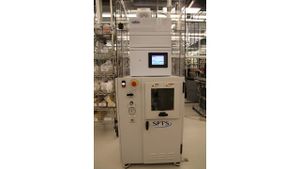Vapor HF Etch: Difference between revisions
Jump to navigation
Jump to search
Content deleted Content added
Text replacement - "/wiki/index.php/" to "/wiki/index.php?title=" |
Text replacement - "/wiki/index.php" to "/w/index.php" |
||
| Line 19: | Line 19: | ||
=Recipes= |
=Recipes= |
||
* See the [https://wiki.nanotech.ucsb.edu/ |
* See the [https://wiki.nanotech.ucsb.edu/w/index.php?title=Other_Dry_Etching_Recipes#Vapor_HF_Etch_.28uETCH.29 Vapor HF Recipes] page for recipe specific to this tool. |
||
* See the general [[Dry Etching Recipes]] page for a table of all etch recipes across all tools. |
* See the general [[Dry Etching Recipes]] page for a table of all etch recipes across all tools. |
||
Revision as of 19:50, 4 September 2021
| |||||||||||||||||||||
About
The applications of this tool are mainly in MEMS-device fabrication areas (releasing a MEMS structure by etching a sacrificial SiO2 layer below) with the use of Al2O3, Al or some other metal as an etch mask at 45oC. The tool uses vapor HF (VHF), EtOH (Ethanol vapor is an Alcohol-based one, ionizing the HF and activating etching, influencing within wafer etch uniformity, and being most compatible with VHF), and N2 gases and can process small sample(s) (on a 8" Si carrier wafer) up to an 8" wafer. There are 5 standard etch recipes installed in the tool with the SiO2 undercut-etch-rate from low to high. The SiO2 undercut-etch-rate is from ~10nm/min to ~350nm/min.
Documentation
Recipes
- See the Vapor HF Recipes page for recipe specific to this tool.
- See the general Dry Etching Recipes page for a table of all etch recipes across all tools.
